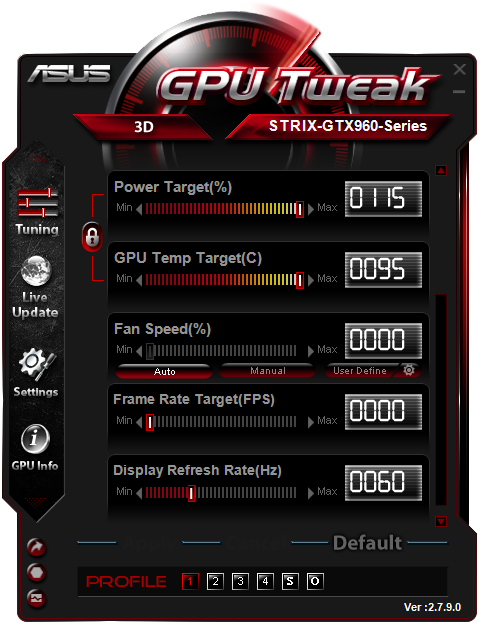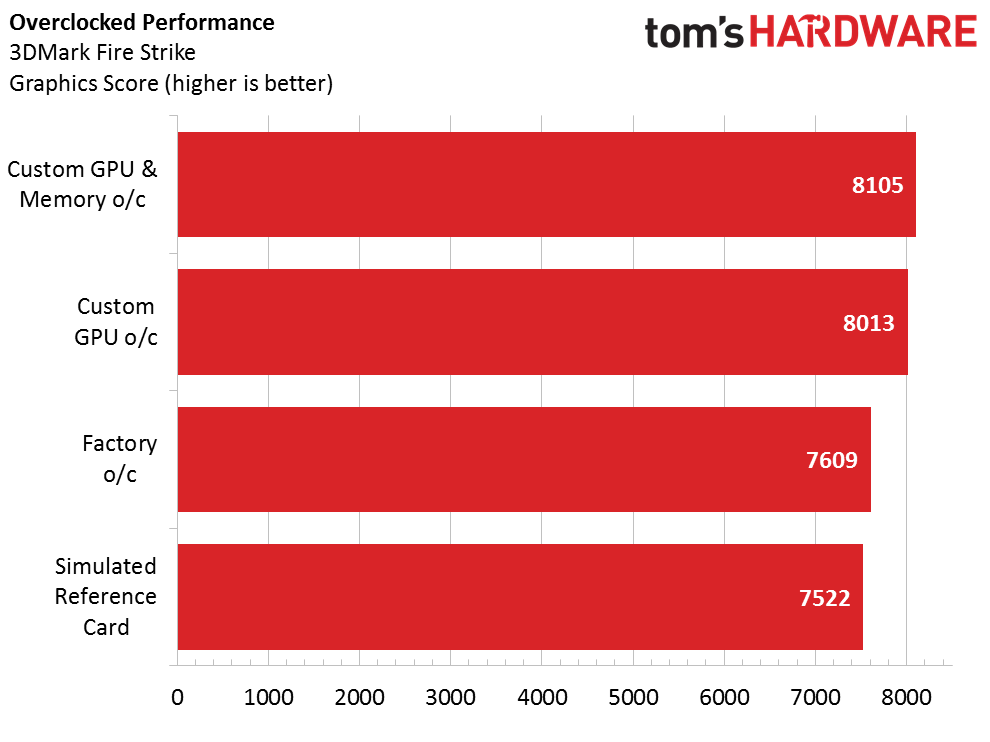Asus GeForce GTX 960 Strix OC Edition Review
With Asus' celebrated DirectCU II cooling, an attractive price tag and Nvidia's GM206 GPU, the GeForce GTX 960 Strix OC Edition has all the makings of a winner.
Why you can trust Tom's Hardware
Overclocking Performance
When it comes to overclocking, your never know what you’re going to get. With that said, we’d be remiss if we didn’t at least try, especially given the GTX 960 Strix OC's cooling hardware.
GPU Tweak is Asus’ own overclocking utility. It allows for direct control of several parameters: GPU Boost Clock, Memory Clock and Fan Speed are available by default.
Enabling advanced mode grants access to GPU Voltage, Power and Temperature Targets, as well as FPS target and refresh rate. The software is fairly straightforward to use. You can adjust the slider bars, or you can click on the numbers and type in values.
Saving a profile is also quite easy. Simply set the parameters you want, click on the save button and a set of numbers appears below. Click on the profile number you want to save to, and that’s it. The next time you click on that profile number at the bottom of the screen, those settings are applied.
The first thing that should be done when overclocking an Nvidia-based GPU is to max the power target. This adjustment allows for the GPU to draw more power than stock. Manufacturers have control of how much power their cards can draw. In this case, Asus sets that to 115%.
Overclocking is a delicate process, so smaller adjustments are best. For this card we started with 20MHz increments. Using this method, the highest stable offset ended up being +120. Even at 125MHz, the GPU was unstable. This gave us a GPU Boost clock rate of 1437MHz, which in-game registers as 1461MHz
After finding the maximum GPU overclock, the memory was adjusted. Using the same method as the GPU, only with 50MHz adjustments, the maximum offset was reached at 250MHz. No amount of voltage would allow for even 5MHz more. After adjustments, the memory was running at 1863MHz.
Get Tom's Hardware's best news and in-depth reviews, straight to your inbox.
Remarkably, even with the overclock the temperature of the GPU never exceeded 62 degrees Celsius.
Kevin Carbotte is a contributing writer for Tom's Hardware who primarily covers VR and AR hardware. He has been writing for us for more than four years.
-
TechyInAZ Very good card by asus, temps are great, size and weight are also surprisingly good for a card like this.Reply
However, the only thing I personally don't like is the looks. I never really liked Asus's cooler designs, I prefer the ACX cooler or Windforce coolers. However this is only a personal preference.
BTW...OP, you put the wrong card on the amazon price list. I think that's the Zotac 960, not the Asus 960. -
ldun So what's better (performance and value wise); 2 of these SLI or a 970 (or even a 980 might be fun to compare)Reply -
TechyInAZ ReplySo what's better (performance and value wise); 2 of these SLI or a 970 (or even a 980 might be fun to compare)
Since this is only the 2GB version, the gtx 970 will run circles around 2 gtx 960s. Nearly every new game will fill that 2GB frame buffer quickly. -
mlga91 A little typo in the 1st paragraph of the 7th section, "When it comes to overclocking, you(r) never know what you’re going to get.".Reply
Looks like a great card, the cooler alone gives a great value for those extra $10, thought an optional second power connector would've been a nice addition, it never hurts to have more available power when it comes to overclocking. -
panathas In your GTX 960 review article you wrote about the asus strix gtx 960 that it produced some power spikes in the motherboard slot. Specifically you wrote " the otherwise very good Asus GTX 960 Strix leaves the motherboard connector to deal with unprecedented unfiltered power spikes all on its own.The very frequent spikes beyond the motherboard slot’s supposed limit won’t cause immediate damage to the hardware, but there might well be long-term repercussions that are hard to judge now. The same goes for how the system might otherwise be impacted with problems such as “chirping” on-board sound when the mouse is moved. The Asus GTX 960 Strix should do a much better job smoothing these spikes out.Reply
Did you test this specific card to see if it still has the same behaviour and if this problem affects the entire asus gtx 960 strix line. I am asking because I was interested in buying this card until I read the above article where you reported this abnormal behaviour. I think you should further investigate this. -
RedJaron Reply
A single card is usually the better option. It's simpler, less headaches worrying about SLI/CFX profiles, etc. Dual GPUs start making sense when you're driving a LOT of pixels, like triple 1080 displays or 4K. But for a single display, even up to 1440 in some cases, get the single strongest card you can reasonably afford.15932532 said:So what's better (performance and value wise); 2 of these SLI or a 970 (or even a 980 might be fun to compare) -
PaulBags The 960sli is an interesting idea, I wondered the same thing when I saw the 4gb 960 strix locally (New Zealand) for half the price of a 980 4gb strix. So for the same price or less you get twice the vram and it actually still works out lower wattage. Only down side I can see is sli support might not always be amazing.Reply -
PaulBags Oh, and 960 has a newer version on open gl than 980, also 960 has a native hvec decorder that 980 doesn't. Can't remember where I read that, but suprised info like that doesn't make it's way to toms.Reply -
skit75 @OPReply
Any speculation as to why the EVGA ACX 2.0 cooler has a lower unloaded temperature? It seems the DirectCU II cooler performs better at load and I would have thought this ratio would be more proportional on the unloaded test. -
PaulBags Reply
It's not mentioned the article but strix has 0db at idle, no fans.15934508 said:@OP
Any speculation as to why the EVGA ACX 2.0 cooler has a lower unloaded temperature? It seems the DirectCU II cooler performs better at load and I would have thought this ratio would be more proportional on the unloaded test.



